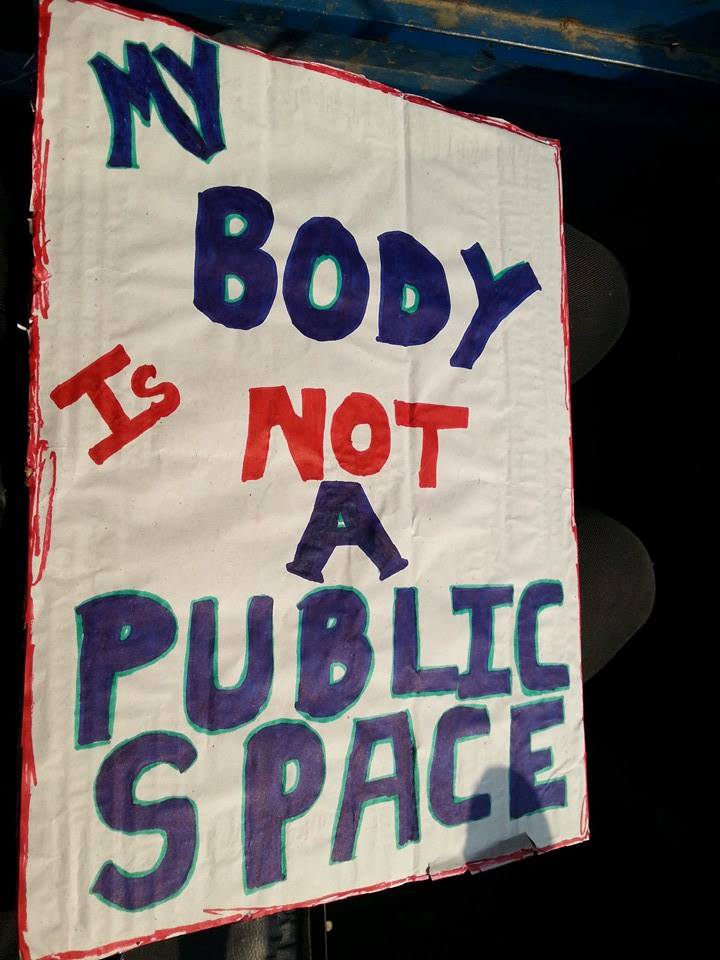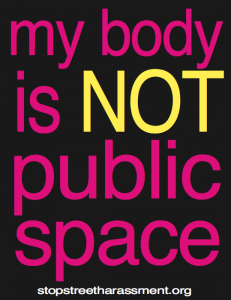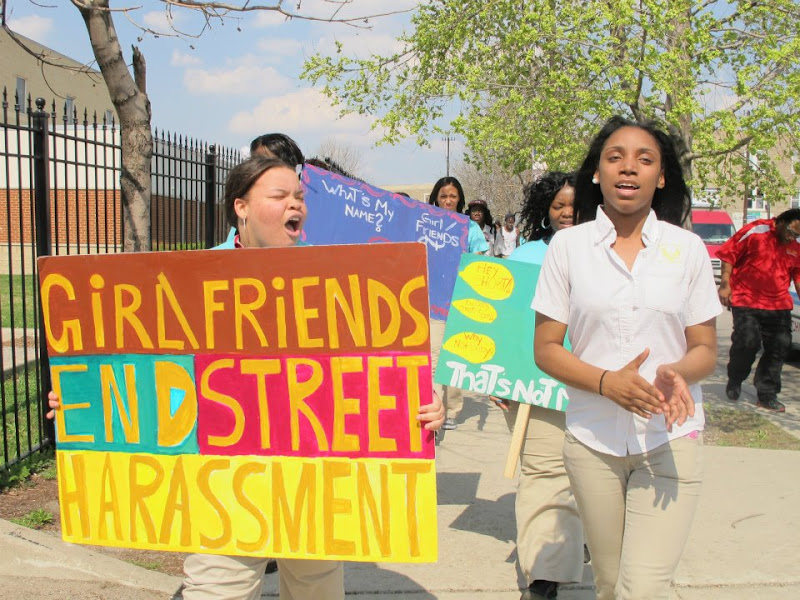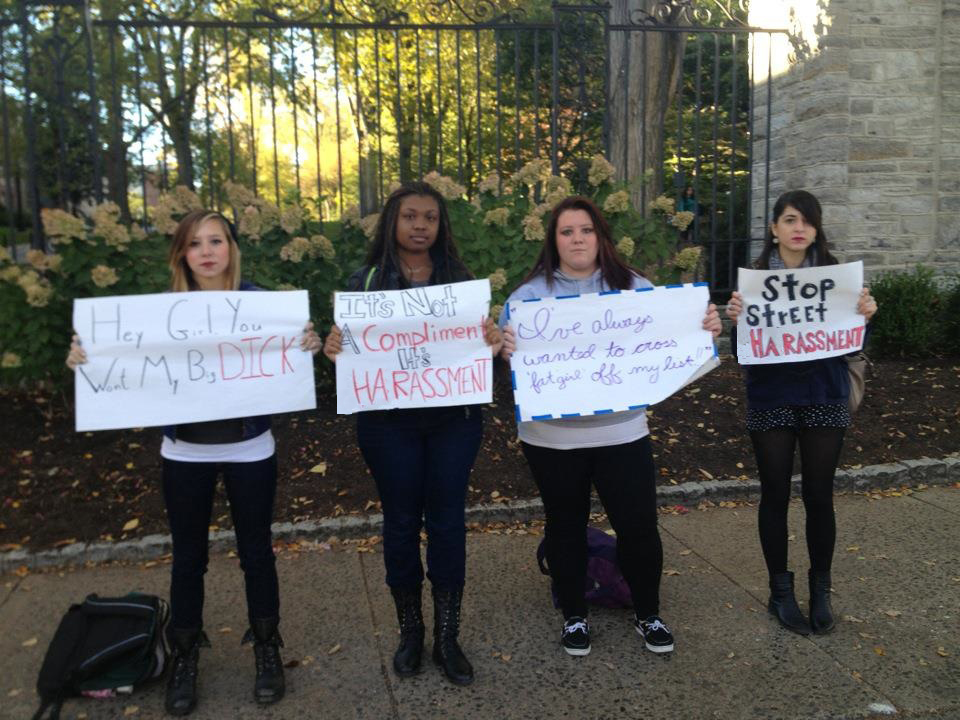
This is Part 1. See Part 2. Read about SSH’s Top 10 Achievements in 2014.
I feel strongly that 2014 has been a turning point year when it comes to raising awareness about street harassment. No longer is it an obscure term describing something that most people see as normal. Now, many more people have some familiarity with it, and a lot of them find it violating and wrong.
A few indicators of this shift:
* There are at least 100 sites where people can share their street harassment stories, plus people’s individual blogs, Tumblrs, and Facebook pages. And people do share their stories every single day.
* I’m emailed more articles per day in my Google Alerts for the term street harassment than in prior years
* Twitter hashtags like #YesAllWomen, #NotJustHello, #YouOkSis?, #Grabbed, #DudesGreetingDudes and #IllRidewithYou were used by tens of thousands of people to talk about street harassment.
* Videos about street harassment in the Chile, France, Peru, and the U.S. each went viral and were viewed by at least 1 million people. The Rob Bliss Creative film “10 Hours of Walking in NYC as a Woman” has been viewed by more than 38 million people to date.
* Stop Street Harassment – particularly because of our new national study of street harassment in the USA – received more than 200 media hits during the year, more than in previous years. Our website traffic was the highest of any other year and we’ve almost reached 20,000 on our Facebook page and 10,000 on Twitter.
* In the U.S., from The Daily Show to Playboy, from Inside Edition to the Today Show, a lot of surprising places did an excellent job of covering street harassment.
* After the New York Post published an article about street harassment being flattering (and women should just deal with it), major outlets like USA Today, Time and Salon.com all ran pieces this afternoon disagreeing, as did sites like Bustle, the Frisky, This would never have happened a few years ago. This is an incredible shift in how street harassment is viewed!!
* Anti-harassment laws passed in countries like Belgium, Egypt, and Peru, and in Kansas City, Missouri, USA.
* The United Nations launched a “He for She” campaign letting men know that they should care about gender equality, too, such as ending street harassment.
There are so many news stories, campaigns, tweet chats, and community efforts that I had to give up trying to track them. I still wanted to write this an annual report blog post, but please know that this is very incomplete. It is just a sampling of all of the news, videos, campaigns and efforts but I think it still provides important documentation for some of what happened this year.
You can also visit the sites of global organizations like UN Women, ActionAid, Huairou Commission, Everyday Sexism, and Hollaback! to read about the important work they are each doing to address street harassment in cities where they have chapters, networks, and programs.
This year has also been very important in the U.S. regarding discussions about racial equality, police profiling and police brutality against persons of color. The conversation and protests gained more traction after the shooting of unarmed teenager Michael Brown in #Ferguson, Missouri in August. After the officer who shot him and the officer who killed another unarmed man (this time caught on video), Eric Garner, were both not indicted by grand juries in December, a tipping point was reached. There have been scores of protests – even around the holidays – die-ins, “Hands Up Don’t Shoot” gestures, and much needed conversations around the country.
While this is not a core issue for SSH, we are allies in this movement. We support justice for all, safe public spaces for all, and police reform so that all (or at least most) police officers will one day take the complaints of sexual harassment, rape, racism, homophobia, transphobia, and hate crimes seriously. We also support the efforts of organizations like Girls for Gender Equity to make sure girls and women of color are included in discussions and initiatives addressing racism.
Okay, on to some highlights and examples of news, activism, and government-led efforts to address street harassment this yea
IMPORTANT NEWS STORIES:
Street harassment is NOT a compliment and it’s not harmless. This was evident this year in many tragic news stories.
* In Brazil, between January and August 2014, 12 young women aged 13-29 were shot and killed by a motorcyclist as they stood in public spaces. The reason? They were young and female.
* A woman in Detroit was shot dead by a harasser after refusing to give him her phone number.
* In India, two teenagers committed suicide because young men in the area kept following them.
* A man in New York slashed the throat of a woman who refused to go on a date with him.
* A man in Seattle pulled out a gun after a woman ignored his repeated invitations to “hang out.”
* A man in England put a woman in a hospital after punching her when she told him to stop touching her.
* Men harassed and violently attacked two transwomen in Atlanta in a subway car, prompting them to move from the city.
* In Chicago, a man put a woman in a headlock and tried to steal her phone after she refused to give him her number on the subway.
Bystanders have experienced violence and murder by harassers this year, too.
* A Chicago man was killed by a harasser in front of his 15-year-old daughter after he confronted the man for making “inappropriate gestures” at her.
* An Egyptian teenager was stabbed to death while stopping to help young women experiencing harassment.
* In Germany, Tugce Albayrak, a 23-year-old student died at the hands of a street harasser when she spoke out to protect two teenage girls.
* A San Francisco man sustained life-threatening injuries after asking a harasser to leave his girlfriend alone.
* A Philadelphia man was hospitalized after he told a harasser to watch what he was saying to women nearby, and the harasser got out of his vehicle and attacked him.
Their stories matter.
Also relevant: UC Santa Barbara student Elliot Rodger ranted about all the hot women who owed him sex before he went on a killing spree in Santa Barbara, California in May. His feelings of entitlement to women’s attention and bodies launched important conversations about men who can’t take no for an answer that included discussions about street harassment.
NEW RESEARCH:
A number of studies helped document the problem of street harassment and helped us better understand various aspects of the social problem.
Global: The World Economic Forum released their annual Global Gender Gap Report in late October. Yet again, no country has achieved gender equality. Street harassment perpetrated by men against women is one more indicator and manifestation of this inequality.
Global: YouGov polling conducted in 16 major cities worldwide asked participants about how safe they feel at night, their experiences with verbal harassment and physical abuse, the public response to abuse, their confidence in authorities, and their overall feelings of safety in the city. They then ranked the 16 cities safest (New York City) to least safe (Bogota).
Global: For one full week in September, Medium asked women from 10 different cities around the globe to keep a diary record of any kind of unwanted attention they received, including every untoward advance from a stranger, every leering stare and smile and “Hey baby” directed their way.
Bangladesh: A survey, jointly conducted by the Bangladesh Bureau of Statistics and United Nations Population Fund and covering all seven divisions of the country, found that 43% of the 12,600 women cited public spaces as the most common spot for experiencing sexual harassment.
Chile: In an opt-in survey, the newly-formed Organization Against Street Harassment (OCAC) “found in its first study that almost 40% of Chilean women are harassed on a daily basis, while 90 percent of women reported having been harassed at least once in their lives.”
India: In a new survey, around 60% of women said they faced harassment and discrimination in the four metros — New Delhi, Mumbai, Kolkata and Bangalore.
Nepal: The World Bank released the report Gender and Public Transport in Nepal that found sexual harassment is a big problem, especially for young women ages 19-25 years old. Among women ages 19-35, one in four had been the target of inappropriate touching during the previous year on public transportation, usually by middle age men.
Saudi Arabia: “A study conducted by a female Saudi researcher about “sexual harassment of women” on a sample of women aged between 18 and 48 has shown that 78% of respondents claimed to have experienced sexual harassment directly, while 92% said that sexual harassment is on the rise. The study found that 27% of them have been subjected to verbal harassment; 26% were subject to “tarqim” attempts, which is the attempt to pass on a phone number; 24% were subject to harassment by looks; and 15% were physically touched.”
USA: SSH commissioned the survey firm GfK to conduct a nationally representative survey of 2,000 people, ages 18 and older, across the country. Nearly two-thirds (65%) of women and 25% of men reported experiencing street harassment. Nearly 1 in 4 women had been sexually touched, 1 in 5 followed, and nearly 1 in 10 forced to do something sexual. Homophobic comments was the most common form of harassment for men, and straight men experienced the least harassment of any group. Men were identified the most often as harassers of both women and men, half of harassed people said the harassment began by age 17, and most harassed persons – especially women – were negatively impacted by the incidents.
USA: The results of the Gallup’s annual Crime survey, conducted Oct. 12-15, found that 37%, of U.S. adults say they would not feel safe walking alone near their home at night. Nearly half of all women, 45%, felt this way. Lower income and younger people were also more likely to say they feel unsafe.
USA: “Adolescent boys who bully peers and engage in homophobic teasing are more likely to perpetrate sexual harassment later on, suggests a new study of middle-school students conducted by researchers at the University of Illinois and the U.S. Centers for Disease Control and Prevention.”
USA: Research shows that men are not “naturally” sexual predators.
USA: A new study found that most young women assume that being harassed, assaulted, and abused is simply something that everyone experiences. Further, the belief that it is normal dissuades most victims from reporting those crimes.
USA: New research provided evidence that sexual harassment is traumatizing for women—especially for those who have experienced sexual abuse.
USA: “A Los Angeles County Metropolitan Transportation Authority survey of nearly 20,000 passengers…asked whether they felt unsafe during the last month while riding Metro due to “unwanted touching, exposure, comments, or any other form of unwanted sexual behavior. About 21% of rail passengers and 18% of bus passengers said yes. About 17% of bus riders and 13% of train riders said they felt unsafe while waiting at bus stops or train stations.”
Vietnam: ActionAid Vietnam and the Hanoi-based Research Center for Gender, Family and Environment in Development surveyed 2,046 people in Hanoi and Ho Chi Minh City in December and 57% of women (aged 16 and up) said sexual harassment is most likely to occur on the street, while 31% of female students said they have been harassed on public buses.
GOVERNMENT-LED EFFORTS
Global: In April, there was a coordinated campaign to address harassment on transit systems called Global Guardian that included British Transport Police (BTP), Transport for London (TfL), Metropolitan Police Service (London), Metro Vancouver Transit Police, Bay Area Rapid Transit Police (San Francisco), Massachusetts Bay Transportation Authority (Boston), and the DC Metro Transit Police Department (MTPD).
Belgium: Sexual harassment in Belgium, including in public spaces, became punishable in the spring by either hefty fines or up to one year in prison. In October, it was reported that “Brussels police write up an average of two fines a day for verbal abuse, mostly targeted at women and gay people. Verbal abuse, such as cat- or name-calling, is prohibited in the capital since a law against street harassment was passed earlier this year.
Canada: In Vancouver, Transit Police launched a text hotline where transit users can send messages about harassment. The text number to report an assault on transit in real time is 87-77-77. They also launched an app to make it easier to report incidents.
Egypt: Egypt passed a law against sexual harassment. It states that a sexual harasser is one who “accosts others in a public or private place through following or stalking them, using gestures or words or through modern means of communication or in any other means through actions that carry sexual or pornographic hints.” The penalty is prison sentence, a fine or both.”
The Egyptian Interior Minister Mohamed Ibrahim ordered a new department formed to combat crimes of violence against women in collaboration with the ministry’s department of human rights. The Egyptian State Council for Women operated a sexual assault hotline during the October Eid al-Adha festivities
Peru: In June, Carmen Omonte, Peru’s Minster of Women and Vulnerable Populations, announced her intention to include sexual street harassment in the penal code as a crime. In August, Peru’s Council of Ministers approved a bill amending Criminal Code to punish street harassment.
UK: “In September 2013 London launched Project Guardian, a collaborative effort by the British Transport Police, the Metropolitan Police, the City of London Police and Transport for London, to boost levels of reporting of sexual offences….2000 officers receive special training and 120 officers – both in uniform and plain clothes – carry out daily patrols on the transport network. Since the launch of the initiative, there has been a 20% increase in the reporting of sexual offences, and a 32% increase in the number of cases where offenders have been charged or summoned.”
USA: In March, the Massachusetts legislature moved swiftly to fix a law that resulted in the Massachusetts Supreme Judicial Court ruling it was legal for a man to take photos up women’s skirts in public places.
USA: In New York City, in October the Metropolitan Transit Authority said it would add cameras in new trains, release new PSAs focused on bystanders, and create improved reporting systems for victims and witnesses as ways to better address sexual harassment and assault.
USA: BikeWalk KC worked with various Kansas City, Missouri groups and the city council to pass an anti-harassment ordinance in October.









